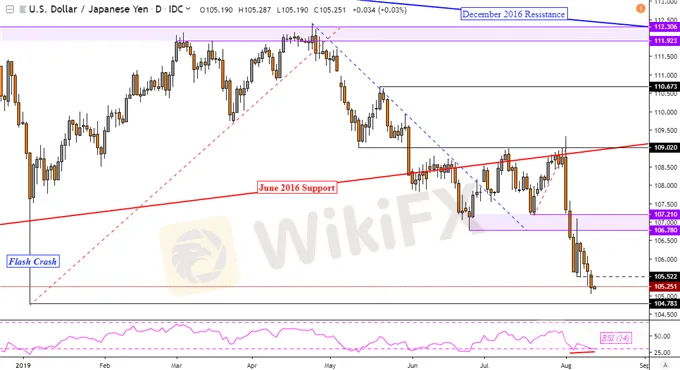简体中文
繁體中文
English
Pусский
日本語
ภาษาไทย
Tiếng Việt
Bahasa Indonesia
Español
हिन्दी
Filippiiniläinen
Français
Deutsch
Português
Türkçe
한국어
العربية
Yen Eyes 2016 Levels as Argentine Peso Collapses, Sentiment Sours
Abstract:The Japanese Yen inched closer to 2016 levels as US-China trade tensions and a collapse in the Argentine Peso soured sentiment. APAC shares may decline, further weakening AUD/USD.
Asia Pacific Market Open Talking Points
Anti-risk Japanese Yen soared as sentiment deteriorated and S&P 500 dropped
Argentine Peso collapsed on primary election, US-China trade wars simmered
USD/JPY aiming for 2016 lows, APAC equities may follow Wall Street lower
Not sure where the Japanese Yen is heading next? Check out the third quarter fundamental and technical forecast!
Japanese Yen Soars as Sentiment Keeps Deteriorating in Financial Markets
The anti-risk Japanese Yen soared as the selloff in global benchmark stock indexes resumed on Monday. Since the beginning of this month, escalating US-China trade tensions have been putting pressure on already-fragile global growth estimates. In response, we have seen central banks across the world respond by cutting rates more aggressively than anticipated such as in New Zealand, India and Brazil.
At the beginning of this week, more developments have been adding to this narrative that poses a threat to emerging markets. In Argentina, the local currency (ARS) and stock index (S&P Merval) collapsed about 15% and 38% respectively. This was on rising fears of a government default after President Mauricio Macri lost the primary election against his opponent Alberto Fernandez.
Meanwhile, risk trends further deteriorated after reports crossed the wires that the People‘s Daily – China’s largest newspaper group – is going to publish a “long article” that the nation could defeat “any challenge” and pressure from the United States. As a reminder, earlier this month US President Donald Trump threatened to raise an additional $300b in tariffs against China come September.
The pro-risk Australian and New Zealand Dollars underperformed against their major counterparts. On Wall Street, the S&P 500 tumbled 1.22 percent as odds of a 50bps Fed interest rate cut for September increased to about 28%.
This is unlike what we have seen earlier this year when prospects of support from the central bank lifted US equities from their bottom in 2018. Despite rising odds of further easing, the US Dollar had a mixed session likely owing to some support as a haven currency.
Tuesdays Asia Pacific Trading Session
With that in mind, we may see Asia Pacific benchmark stock indexes follow their North American peers to the downsides which could extend gains in the Japanese Yen. The Australian Dollar, which may be vulnerable in this scenario, also has to contend with upcoming business confidence data. A more pessimistic outcome compared to June may further inspire near-term RBA rate cut bets.
Japanese Yen Technical Analysis
Taking a closer look at the USD/JPY daily chart, the currency pair is approaching the “flash crash” low at 104.78. This followed the break under former support between 106.78 and 107.21. This is also in-line with my third quarter Yen technical forecast as the pair looks to confirm a long-term bearish continuation pattern that may result in testing lows from 2016.
USD/JPY Daily Chart

Disclaimer:
The views in this article only represent the author's personal views, and do not constitute investment advice on this platform. This platform does not guarantee the accuracy, completeness and timeliness of the information in the article, and will not be liable for any loss caused by the use of or reliance on the information in the article.
Read more

GEMFOREX - weekly analysis
The week ahead: Top 5 things to watch

Japanese Yen Technical Analysis: EUR/JPY, CAD/JPY. What Happened to Momentum?
JAPANESE YEN, EUR/JPY, CAD/JPY - TALKING POINTS AND ANALYSIS

Japanese Yen Technical Analysis: USD/JPY, AUD/JPY. Are They Establishing Ranges?
JAPANESE YEN, USD/JPY, AUD/JPY - TALKING POINTS

Relationship Between Abe and Japanese Yen
Shinzo Abe, the longest-serving Japanese Prime Minister in history, has suddenly resigned on August 28, citing health reasons.
WikiFX Broker
Latest News
BASF CEO: EU CO₂ Trading Is A "Destruction Mechanism" For European Industry
Is Fyntura a Regulated Broker? A Complete 2025 Broker Review
Zetradex Exposed: Withdrawal Denials, Account Freeze & Bonus Issues Hurt Traders
Is Forex Zone Trading Regulated and Licensed?
PINAKINE Broker India Review 2025: A Complete Guide to Safety and Services
Exness Restricted Countries List 2025 Explained
Is Uniglobe Markets Legit? A 2025 Simple Guide to Its Safety, Services, and User Warnings
Is Inzo Broker Safe or a Scam? An Evidence-Based Analysis for Traders
WikiEXPO Dubai 2025 “Welcome Party” Kicks Off Tonight!
He Trusted a WhatsApp Group and Lost RM659,000
Currency Calculator



